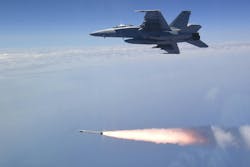Northrop Grumman preparing to build more lots of AGM-88G AARGM-ER aircraft-launched radar-killing missile
PATUXENT RIVER NAS, Md. – U.S. Navy aerial warfare experts are preparing for future orders of the AGM-88G Advanced Anti-Radiation Guided Missile-Extended Range (AARGM-ER) to equip U.S. military combat aircraft.
Officials of the Naval Air Systems Command at Patuxent River Naval Air Station, Md., announced a $33.2 million contract to the Northrop Grumman Corp. Mission Systems segment in Northridge, Calif., in September for long-lead items to maintain the AARGM-ER planned production schedule.
The long-range AARGM-ER is the newest version of the AGM-88 missile, and is compatible with U.S. and allied strike aircraft, including the F/A-18 fighter bomber, EA-18G electronic warfare jet, F-16, and F-35.
Long-lead items either are difficult and time-consuming to obtain, and are funded early in the missile's design process to keep overall production on schedule. Actual contracts for the missile will come later.
The AARGM radar-killing missile features an advanced digital anti-radiation homing sensor, millimeter wave radar terminal seeker, global positioning system (GPS) guidance, inertial navigation system guidance, net-centric connectivity, and weapon-impact-assessment (WIA) transmit.
The AGM-88G enables the U.S. Navy, U.S. Marine Corps, and allied combat jets to attack and destroy enemy air-defense radar systems and time-critical mobile targets.
The missile offers improved capabilities over the HARM systems it replaces, including advanced signal processing, improved frequency coverage, detection range, and field of view; time-critical, standoff strike; missile-impact zone control to prevent collateral damage; counter-emitter shutdown through active millimeter wave radar terminal guidance; and bomb damage assessment.
The AGM-88G AARGM-ER uses the guidance system and warhead of the AGM-88E, and uses a solid integrated rocket-ramjet engine to double AGM-88E's range. It incorporates a redesigned control section and 11.5-inch diameter rocket motor for twice the range and internal carriage on the Lockheed Martin F-35A and F-35C Lightning II Joint Strike Fighter.
The AGM-88G, integrates the AGM-88E's warhead and guidance systems in a new airframe that replaces the mid-body wings with aerodynamic strakes along the sides with control surfaces relocated to low-drag tail surfaces and a more powerful propulsion system for greater speed and double the range of its predecessor. The AGM-88G weighs 1,030 pounds and is 13.3 feet long.
The AARGM-ER features new software and enhanced capabilities to counter radar shutdown and passive radar using an additional active millimeter wave seeker. Previous versions of the missile could be spoofed by turning off radar before the weapon could lock on to their signals.
On this contract Northrop Grumman will do the work in Rocket Center, W.Va.; San Diego and Northridge, Calif.; Lewisburg, Tenn.; Andover, Mass.; Plymouth, Maine; Nampa, Ind.; Huntsville, Ala.; and at locations outside of the U.S., and should be finished by March 2026.
For more information contact Northrop Grumman Mission Systems online at www.northropgrumman.com/who-we-are/business-sectors/mission-systems, or Naval Air Systems Command at www.navair.navy.mil.
About the Author
John Keller
Editor-in-Chief
John Keller is the Editor-in-Chief, Military & Aerospace Electronics Magazine--provides extensive coverage and analysis of enabling electronics and optoelectronic technologies in military, space and commercial aviation applications. John has been a member of the Military & Aerospace Electronics staff since 1989 and chief editor since 1995.
